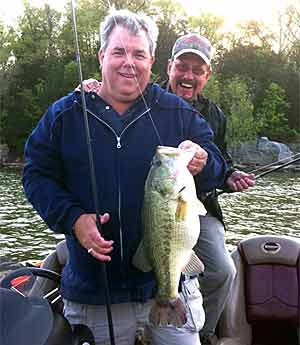Bass Are

Cold Blooded:
Their body temperature and more importantly, their metabolism is controlled by water temperature. The warmer the water, the higher their metabolism. Bass are most active between about 60 degrees and 75 degrees. Below about 50 degrees, their metabolism slows down, causing them to eat infrequently. Above about 80 degrees, low dissolved oxygen levels in the water place them under stress. Dead perch may be an indication of low oxygen levels.
What's more important than the current water temperature is what's happening to it (i.e. is it going up or down?). Changes in water temperature affect shallow bass much more than those residing in deep water. Keep in mind that water temperature is but one factor to consider when putting together a fishing strategy.
A Schooling Fish:
If you catch a bass, you're likely to catch another in the same area. So once you "locate" bass, slow down and fish the area thoroughly. But don't put caught fish back in the water. Instead, put them in the livewell if you want to catch more fish. Panicked bass will scare the others off.
Pay attention to depth: the deeper the water, the tighter the school. Bass of similar sizes tend to school together.
Near Bottom:
Bass usually will be on the bottom or something that represents bottom. Usually, the closer to the bottom they are, the more they're in a position to feed. Knowing where the bottom is dictates what type of lure you use. Bottom contour, composition and depth play important roles in finding bass.
Predators:
Bass are predators - they like live prey. But they don't hunt for prey, instead they prefer to lie in wait for an unsuspecting victim to happen by. Therefore, casting accuracy and presentation are vital to bass fishing success.
Seek Safety:
While bass are a predator fish, they can also become the prey. Bass use cover and depth as refuge from other predators. Smallmouths and spotted bass prefer deeper water than do largemouths. But even largemouths - which may be found in water only inches deep - require relatively deep water to be nearby.
Near Structure:
Bass use objects as places to launch an ambush. They'll use just about anything - pilings, rocks, tires, wood, bushes, weeds, sunken objects or anything "different" from the bottom.
Near Edges:
When in a feeding mood, bass will position themselves on edges or "transitions" of any sort because it's easier to dart out and catch their prey. Bass prefer to be at or near the junction of any two or more features, including: small rocks and big rocks; shallow water and deep water; shady areas and sunlit areas; current and still water; weeds and open water; emergent weeds and mossy weeds; wood cover and weedy cover; etc.
Opportunistic:
Bass usually feed on crawfish, sculpin, and minnows. They won't stay long where there's no food so learn where to find the prevalent and preferred food types in each season, and you'll find bass. They will eat an easy meal, so crippled and injured prey are they're first choice - even if it's not on their main menu. Bass have been known to eat worms, insects, panfish, frogs, lizards, salamanders, snakes and even birds!
Spawners:
Through much of the year, particularly from late winter through spring, bass usually can be found in or near spawning areas, namely fairly shallow, flat areas with some cover and with quick access to deeper water. Everything they do throughout the year is connected to the spawn. When searching for beds, keep in mind that generally the deeper the bed, the bigger the bass.



